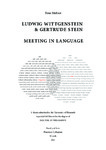Ludwig Wittgenstein & Gertrude Stein – Meeting in Language
| dc.contributor.supervisor | Grant, Ms Jane | |
| dc.contributor.author | Melzer, Tine | |
| dc.contributor.other | Faculty of Arts, Humanities and Business | en_US |
| dc.date.accessioned | 2015-01-05T09:13:17Z | |
| dc.date.available | 2015-01-05T09:13:17Z | |
| dc.date.issued | 2014 | |
| dc.identifier | 10193696 | en_US |
| dc.identifier.uri | http://hdl.handle.net/10026.1/3183 | |
| dc.description | Former Director of Studies: Professor Antonio Caronia | en_US |
| dc.description.abstract |
Tine Melzer: Ludwig Wittgenstein & Gertrude Stein – Meeting in Language The purpose of this study is to show transitions between verbal and visual meaning in ordinary language, based on philosophical concepts and conceptual artworks. It offers models for artistic research and collaboration in arts and science. Shared experiences in ordinary language are fundamental to this thesis and make it an accessible and trans-disciplinary study. Language as such, is approached from different practices and disciplines and becomes the central object of investigation. The research introduces a general set of mechanisms in language, stemming from the Wittgensteinian notion of the language-game. The study examines the possibility of a meeting between the philosopher Ludwig Wittgenstein and the writer Gertrude Stein in a linguistic, biographical and poetic sense. The main claim is that Wittgenstein and Stein share the understanding of language as a game, which is a fruitful principle for artistic and poetic production. Gertrude Stein developed a dimension in her writing which partly succeeds in showing this notion of creating meaning-as-practice and making sense on the ‘edge’ of conventional meaning. In this way she augments Wittgenstein’s idea of the language-game and puts it into practice, tests its limits on her own language and on the reader’s habits. The artistic works represented in this thesis are equally experimental tests of Wittgenstein’s meaning-as-use hypothesis. They put his ideas into practice. They extend the research with strategies from the arts, poetry and fiction. The methodology of the research is based on Wittgenstein’s notion of meaning as context-dependent use. This concept defines the meaning of a word by the way it is used in a specific context. This perspective is then challenged with visual artistic work. This hypothesis is tested throughout the research by applying tools and concepts from several practices, like computer linguistic tools, collaboration with writers and artists from other fields and autonomous visual and poetic work to augment the study of facts. Conceptual artworks, often produced in collaboration, function as language experiments, or language-games. The Wittgensteinian differentiation between what can be shown and what can be said is examined. The context of the research lies in the practices developed as a conceptual artist in which theoretical research informs artistic practice. This thesis, on the border between verbal and visual language, is founded upon antecedent studies in philosophy of language and the practice of Fine Arts. Against this background the research focuses on the relationship between word, context and meaning: issues of communication, ordinary language, words and their composition, context-based meaning, naming visual phenomena, examination of word-and-world-relationships and vocabularies. Main sources are the major works and biographies of Ludwig Wittgenstein, Gertrude Stein, the critical work of Marjorie Perloff, language philosophers concerned with ordinary language and the contrastive corpus linguistic approach. The results of this research are generated by several interdisciplinary productive methods. Artworks, poetic and scientific work, all of which employ modes of language, and whose their domains overlap. Additionally, the notion of meeting acts as model metaphor for the development of a solid trans-disciplinary methodology for research between science and the arts. One major result of comparing their ideas on language is reflected in the meeting of the language used by Wittgenstein and Stein. Their meeting is materialized in the computer generated Shared Vocabulary, which is a list of words which both Wittgenstein and Stein used in their writing. It applies linguistic tools from contrastive corpus linguistics to compare their vocabularies (corpora), which offers new methods for investigating the works of the philosopher Wittgenstein and writer Stein. Generally, this thesis may act as an introduction to language as ideal fundament for interdisciplinary study. The application of the principle of the language-game (Wittgenstein) is a significant of displaying possible strategies for artists and researchers who work transdisciplinarily. The research results directly inform practice and practitioners from other fields, which means that collaboration is central to the research. It implies that language permeates every sort of research, art and its discourse. It also suggests that the meaning of words and images depend on their use, which extends the Wittgensteinian meaning-as-use hypothesis to visual language. The findings of the research on vocabularies are quite specific, but they overlap with offering simple general mechanisms of the language-game. The consequent alliance of the discussion with the language of the everyday makes the research a general contribution to everyone who is genuinely interested in language and the arts. | en_US |
| dc.description.sponsorship | Parts of this research were supported by The Netherlands Foundation for Visual Arts, Design and Architecture (Fonds BKVB, Studiebeurs)and Prins Bernhard Cultuurfonds Amsterdam (Cultuurfondsbeurs) | en_US |
| dc.language.iso | en | en_US |
| dc.publisher | Plymouth University | en_US |
| dc.subject | Language-game | en_US |
| dc.subject | Vocabulary | |
| dc.subject | Ludwig Wittgenstein | |
| dc.subject | Gertrude Stein | |
| dc.subject | Artistic research | |
| dc.subject | Meeting | |
| dc.subject | Language | |
| dc.subject | Art practice | |
| dc.title | Ludwig Wittgenstein & Gertrude Stein – Meeting in Language | en_US |
| dc.type | Thesis | |
| plymouth.version | Full version | en_US |
| dc.identifier.doi | http://dx.doi.org/10.24382/3491 |
Files in this item
This item appears in the following Collection(s)
-
01 Research Theses Main Collection
Research Theses Main


